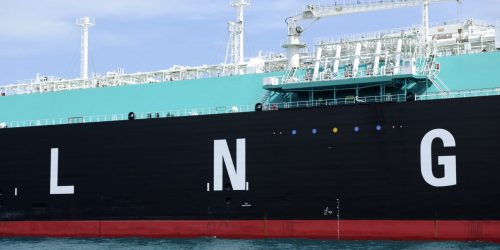ISLAMABAD:
The government has formed a committee to take policy decision in consultation with liquefied natural gas (LNG) terminal developers for utilising idle capacity of the terminal operators.
The Pakistan Tehreek-e-Insaf (PTI) government had approved utilisation of the idle capacity of the existing LNG terminals by private parties in July 2019 but not a single ship could be brought by the private sector due to monopoly of state-run companies.
The private sector has been eager to import LNG for its consumption but has not been able to do so due to a number of reasons, including the long-term LNG supply contract with Qatar at a higher price. Pakistan State Oil (PSO) and Pakistan LNG Limited (PLL) are the two state-owned companies that are importing LNG.
In Pakistan, the use of imported gas has remained low mainly due to it being expensive. The LNG import plan was implemented by the previous government to utilise the imported gas in the power sector. However, the power sector has been reluctant to consume LNG due to its higher prices.
The private sector claims it can import LNG at cheaper rates as it does not have to comply with Public Procurement Regulatory Authority (PPRA) rules and can import the gas anytime. However, the government entities importing LNG have raised concerns about lack of utilisation of gas being imported from Qatar as private parties will be out of the system.
At present, a major consumer is the textile sector because the government has given subsidy and is providing imported gas at half the rate.
The private sector also claims Pakistan has missed an opportunity, when LNG prices plunged to $2 per million British thermal units (mmbtu) following the Covid-19 outbreak, by denying them permission for gas import.
It has conducted a study that suggests LNG prices will remain at around $3 per mmbtu over the next five years and, therefore, it should be allowed to reap benefits of low prices.
LNG consumers had already paid an additional $45 million in 2018 because of the unutilised capacity of LNG terminals and the same amount was estimated to have been paid in 2019 due to less capacity utilisation.
Sources said the minister for maritime affairs highlighted the issue of third-party access to the government-contracted unutilised capacity in a recent meeting of the cabinet because the matter had been lingering on for quite some time, causing financial loss to the national exchequer.
It was explained that the issue was placed before the Economic Coordination Committee (ECC) in July 2019 but decision was delayed due to subsequent litigation.
The cabinet ratified the ECC decision on third-party access to LNG terminals. However, it said instead of a two-member committee, comprising the minister for maritime affairs and special assistant to the prime minister on petroleum, a committee, headed by the Planning Commission deputy chairman, with finance, petroleum and maritime affairs’ secretaries as members, would be constituted.
It would assess and finalise financial benefit to the relevant state entity for a policy decision, based on consultations with terminal developers, within two weeks and report back to the ECC for approval.
Earlier, the ECC had approved the allocation of excess capacity of the second LNG terminal to private parties. Compressed natural gas (CNG), fertiliser, industrial and power sectors are trying to get the allocation of unutilised capacity.
The federal cabinet, in its decision on July 1, 2020, referred the matter of third-party access to LNG terminals to the ECC for further discussion along with the earlier decision on the use of excess capacity by third parties. The cabinet discussion remained focused on revenue sharing while maintaining priority rights of the government in the use of contracted capacity.
Regarding third-party access to the unutilised government-contracted capacity of the second terminal, a viable option will be to offer such capacity to private parties on a three-month forward visibility basis, keeping in mind the increasing utilisation by the government itself.
Total capacity of terminal-1 and terminal-2 is 690 million cubic feet per day (mmcfd) and 750 mmcfd respectively.
For terminal-1, Sui Southern Gas Company (SSGC) has contracted a re-gasification capacity of 630 mmcfd with peak capacity of 690 mmcfd, as and when required, and is fully utilising it through PSO-contracted term cargoes.
For terminal-2, Pakistan LNG Terminals Limited (PLTL) has a contacted capacity of 600 mmcfd with peak capacity of 690 mmcfd, as and when required. Through this terminal, PLL imports two LNG cargoes per month (nearly 200 mmcfd) on a term contract basis whereas additional LNG imports are made through spot tenders to meet gas requirement of the country.
The second terminal stands underutilised with average utilisation of nearly 62% and 51% in FY19 and FY20 respectively. The drop in demand was primarily on account of Covid-19 and its utilisation may go above 70% with the start of 150 mmcfd of regasified LNG supply to K-Electric, which is expected in March 2021.





